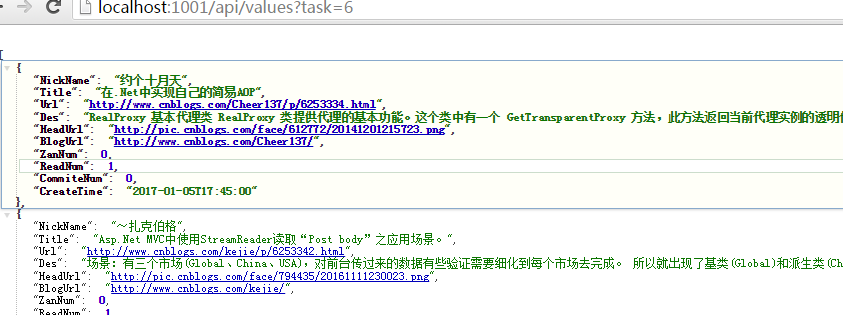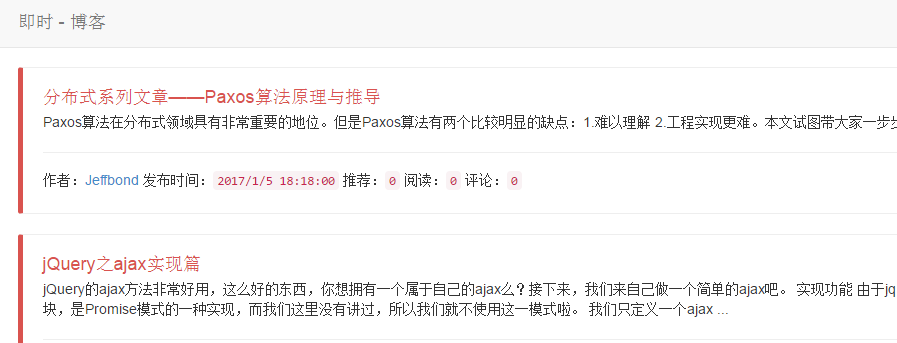
本篇将要和大家分享的是How to use dependency injection in webapi,依赖注入这个东西在接口中常用,实际工作中也用的比较频繁,因此这里分享两种在api中依赖注入的方式Ninject和Unity。下面跟着小编一起来看下吧
本篇将要和大家分享的是How to use dependency injection in webapi,依赖注入这个东西在接口中常用,实际工作中也用的比较频繁,因此这里分享两种在api中依赖注入的方式Ninject和Unity;由于快过年这段时间打算了解下vue.js,所以后面对webapi的分享文章可能会慢点更新,希望支持的朋友们多多谅解,毕竟只有不断充电学习,才能更好的适应it行业吧;本章内容希望大家喜欢,也希望各位多多扫码支持和推荐谢谢:
» Task并行任务抓取博客园首页信息
» IOC框架Ninject的使用
» IOC框架Unity的使用
下面一步一个脚印的来分享:
» Task并行任务抓取博客园首页信息
首先,咋们需要创建一个博客信息实体类 MoBlog ,实体类代码如下:
public class MoBlog
{
public MoBlog() { }
/// <summary>
/// 作者昵称
/// </summary>
public string NickName { get; set; }
/// <summary>
/// 标题
/// </summary>
public string Title { get; set; }
/// <summary>
///该篇文字地址
/// </summary>
public string Url { get; set; }
/// <summary>
/// 描述
/// </summary>
public string Des { get; set; }
/// <summary>
/// 头像图片地址
/// </summary>
public string HeadUrl { get; set; }
/// <summary>
/// 博客地址
/// </summary>
public string BlogUrl { get; set; }
/// <summary>
/// 点赞次数
/// </summary>
public int ZanNum { get; set; }
/// <summary>
/// 阅读次数
/// </summary>
public int ReadNum { get; set; }
/// <summary>
/// 评论次数
/// </summary>
public int CommiteNum { get; set; }
/// <summary>
/// 创建时间
/// </summary>
public DateTime CreateTime { get; set; }
}然后,需要创建一个接口 IBlogsReposity ,并且定义一个如下代码的方法:
public interface IBlogsReposity
{
/// <summary>
/// 获取博客信息
/// </summary>
/// <param>
/// <returns></returns>
Task<ienumerable>> GetBlogs(int nTask);
}</ienumerable>注意这里定义的返回类型是Task
public class BoKeYuan : IBlogsReposity
{
public async Task<ienumerable>> GetBlogs(int nTask)
{
var blogs = new List<moblog>();
try
{
//开启nTask个任务,读取前nTask页信息
Task<ienumerable>>[] tasks = new Task<ienumerable>>[nTask];
for (int i = 1; i >>((page) =>
{
return GetBlogsByPage(Convert.ToInt32(page));
}, i);
}
//30s等待
Task.WaitAll(tasks, TimeSpan.FromSeconds(30));
foreach (var item in tasks.Where(b => b.IsCompleted))
{
blogs.AddRange(item.Result);
}
}
catch (Exception ex)
{
}
return blogs.OrderByDescending(b => b.CreateTime);
}
/// <summary>
///
/// </summary>
/// <param>页数
/// <returns></returns>
async Task<ienumerable>> GetBlogsByPage(int nPage)
{
var blogs = new List<moblog>();
try
{
var strBlogs = string.Empty;
using (HttpClient client = new HttpClient())
{
strBlogs = await client.GetStringAsync("http://www.cnblogs.com/sitehome/p/" + nPage);
}
if (string.IsNullOrWhiteSpace(strBlogs)) { return blogs; }
var matches = Regex.Matches(strBlogs, "diggnum\"[^>]+>(?<hzan>\\d+)[^:]+(?<burl>http[^\"]+)[^>]+>(?<title>[^[^=]+=[^=]+=\"(?<hurl>http://(\\w|\\.|\\/)+)[^>]+>[^\\/]+\\/\\/(?<hphoto>[^\"]+)[^(?<bdes>[^]+>(?<hname>[^[^\\d+)[^\\(]+\\((?<bread>\\d+)");
if (matches.Count <p></p>
<p>代码分析:</p>
<p>1. Task<ienumerable>>[] tasks = new Task<ienumerable>>[nTask]作为并行任务的容器;</ienumerable></ienumerable></p>
<p>2. Task.Factory.StartNew创建对应的任务</p>
<p>3. Task.WaitAll(tasks, TimeSpan.FromSeconds(30));等待容器里面任务完成30秒后超时</p>
<p>4. 最后通过把item.Result任务结果添加到集合中,返回我们需要的数据</p>
<p>这里解析博客内容信息用的正则表达式,这种方式在抓取一定内容上很方便;群里面有些朋友对正则有点反感,刚接触的时候觉得挺不好写的,所以一般都采用更复杂或者其他的解析方式来获取想要的内容,这里提出来主要是和这些朋友分享下正则获取数据是多么方便,很有必要学习下并且掌握常规的用法,这也是一种苦尽甘来的体验吧哈哈;</p>
<p>好了咋们创建一个webapi项目取名为 Stage.Api ,使用她自动生成的 ValuesController 文件里面的Get方法接口来调用咋们上面实现的博客抓取方法,代码如下:</p>
<p></p>
<pre class="brush:php;toolbar:false">// GET api/values
public async Task<ienumerable>> Get(int task = 6)
{
task = task 50 ? 50 : task;
IBlogsReposity _reposity = new BoKeYuan();
return await _reposity.GetBlogs(task);
}</ienumerable>这里使用 IBlogsReposity _reposity = new BoKeYuan(); 来创建和调用具体的实现类,这里贴出一个线上抓取博客首页信息的地址(不要告诉dudu):http://www.php.cn/:1001/api/values?task=6;咋们来想象一下,如果这个Get方法中还需要调用其他实现了接口 IBlogsReposity 的博客抓取类,那咋们又需要手动new一次来创建对应的对象;倘若除了在 ValuesController.cs 文件中调用了博客数据抓取,其他文件还需要这抓取数据的业务,那么又会不停的new,可能有朋友就会说那弄一个工厂模式怎么样,不错这是可行的一种方式,不过这里还有其他方法能处理这种问题,比如:ioc依赖注入;因此就有了下面的分享内容。
» IOC框架Ninject的使用
首先,我们要使用ninject需要使用nuget下载安装包,这里要注意的是Ninject版本比较多,需要选择合适自己webapi的版本,我这里选择的是:

看起来很老了哈哈,不过咋们能用就行,安装起来可能需要点时间,毕竟比较大么也有可能是网络的问题吧;安装完后咋们创建一个自定义类 NinjectResolverScope 并实现接口 IDependencyScope , IDependencyScope 对应的类库是 System.Web.Http.dll (注:由于webapi2项目自动生成时候可能勾选了mvc,mvc框架里面也包含了一个IDependencyScope,所以大家需要注意区分下),好了咋们来直接看下 NinjectResolverScope 实现代码:
/// <summary>
/// 解析
/// </summary>
public class NinjectResolverScope : IDependencyScope
{
private IResolutionRoot root;
public NinjectResolverScope() { }
public NinjectResolverScope(IResolutionRoot root)
{
this.root = root;
}
public object GetService(Type serviceType)
{
try
{
return root.TryGet(serviceType);
}
catch (Exception ex)
{
return null;
}
}
public IEnumerable<object> GetServices(Type serviceType)
{
try
{
return this.root.GetAll(serviceType);
}
catch (Exception ex)
{
return new List<object>();
}
}
public void Dispose()
{
var disposable = this.root as IDisposable;
if (disposable != null)
disposable.Dispose();
this.root = null;
}
}</object></object>这里要注意的是GetService和GetServices方法必须使用 try...catch() 包住,经过多方调试和测试,这里面会执行除手动bind绑定外的依赖,还会执行几个其他非手动绑定的实例对象,这里使用try避免抛异常影响到程序(其实咋们可以在这里用代码过滤掉非手动绑定的几个实例);这里也简单说下这个 NinjectResolverScope 中方法执行的先后顺序:GetService=》GetServices=》Dispose,GetService主要用来获取依赖注入对象的实例;好了到这里咋们还需要一个自定义容器类 NinjectResolverContainer ,该类继承自上面的 NinjectResolverScope 和实现 IDependencyResolver 接口(其实细心的朋友能发现这个 IDependencyResolver 同样也继承了 IDependencyScope ),具体代码如下:
public class NinjectResolverContainer : NinjectResolverScope, IDependencyResolver
{
private IKernel kernel;
public static NinjectResolverContainer Current
{
get
{
var container = new NinjectResolverContainer();
//初始化
container.Initing();
//绑定
container.Binding();
return container;
}
}
/// <summary>
/// 初始化kernel
/// </summary>
void Initing()
{
kernel = new StandardKernel();
}
/// <summary>
/// 绑定
/// </summary>
void Binding()
{
kernel.Bind<iblogsreposity>().To<bokeyuan>();
}
/// <summary>
/// 开始执行
/// </summary>
/// <returns></returns>
public IDependencyScope BeginScope()
{
return new NinjectResolverScope(this.kernel.BeginBlock());
}
}</bokeyuan></iblogsreposity>这里能够看到 IKernel kernel = new StandardKernel(); 这代码,她们引用都来源于我们安装的Ninject包,通过调用初始化Initing()后,我们需要在Binding()方法中手动绑定我们对应需要依赖注入的实例,Ninject绑定方式有很多种这里我用的格式是: kernel.Bind().To(); 如此简单就实现了依赖注入,每次我们需要添加不同的依赖项的时候只需要在这个Binding()中使用Bind.To()即可绑定成功;好了为了验证咋们测试成功性,我们需要在apiController中使用这个依赖关系,这里我使用构造函数依赖注入的方式:
private readonly IBlogsReposity _reposity
public ValuesController(IBlogsReposity reposity)
{
_reposity = reposity;
}
// GET api/values
public async Task<ienumerable>> Get(int task = 6)
{
task = task 50 ? 50 : task;
return await _reposity.GetBlogs(task);
}</ienumerable>代码如上所示,我们运行下程序看下效果:

这个时候提示了个错误“没有默认构造函数”;我们刚才使用的构造函数是带有参数的,而自定义继承的 ApiController 中有一个无参数的构造函数,根据错误提示内容完全无解;不用担心,解决这个问题只需要在 WebApiConfig.cs 中Register方法中增加如下代码:
//Ninject ioc config.DependencyResolver = NinjectResolverContainer.Current;
这句代码意思就是让程序执行上面咋们创建的容器 NinjectResolverContainer ,这样才能执行到我能刚才写的ioc程序,才能实现依赖注入;值得注意的是 config.DependencyResolver 是webapi自带的提供的,mvc项目也有同样提供了 DependencyResolver 给我们使用方便做依赖解析;好了这次我们在运行项目可以得到如图效果:

» IOC框架Unity的使用
首先,安装Unity和Unity.WebAPI的nuget包,我这里的版本是:

我们再同样创建个自定义容器类 UnityResolverContainer ,实现接口 IDependencyResolver (这里和上面Ninject一样);然后这里贴上具体使用Unity实现的方法:
public class UnityResolverContainer : IDependencyResolver
{
private IUnityContainer _container;
public UnityResolverContainer(IUnityContainer container)
{
this._container = container;
}
public IDependencyScope BeginScope()
{
var scopeContainer = this._container.CreateChildContainer();
return new UnityResolverContainer(scopeContainer);
}
/// <summary>
/// 获取对应类型的实例,注意try...catch...不能够少
/// </summary>
/// <param>
/// <returns></returns>
public object GetService(Type serviceType)
{
try
{
//if (!this._container.IsRegistered(serviceType)) { return null; }
return this._container.Resolve(serviceType);
}
catch
{
return null;
}
}
public IEnumerable<object> GetServices(Type serviceType)
{
try
{
return this._container.ResolveAll(serviceType);
}
catch
{
return new List<object>();
}
}
public void Dispose()
{
if (_container != null)
{
this._container.Dispose();
this._container = null;
}
}
}</object></object>这里和使用Ninject的方式很类似,需要注意的是我们在安装Unity包的时候会自动在 WebApiConfig.cs 增加如下代码:
//Unity ioc UnityConfig.RegisterComponents();
然后同时在 App_Start 文件夹中增加 UnityConfig.cs 文件,我们打开此文件能看到一些自动生成的代码,这里我们就可以注册绑定我们的依赖,代码如:
public static class UnityConfig
{
public static void RegisterComponents()
{
var container = new UnityContainer();
container.RegisterType<iblogsreposity>();
// var lifeTimeOption = new ContainerControlledLifetimeManager();
//container.RegisterInstance<iblogsreposity>(new BoKeYuan(), lifeTimeOption);
GlobalConfiguration.Configuration.DependencyResolver = new UnityResolverContainer(container);
}
}</iblogsreposity></iblogsreposity>这里展示了两种注册依赖的方式: container.RegisterType
public class ValuesController : ApiController
{
private readonly IBlogsReposity _reposity;
public ValuesController(IBlogsReposity reposity)
{
_reposity = reposity;
}
// GET api/values
public async Task<ienumerable>> Get(int task = 6)
{
task = task 50 ? 50 : task;
return await _reposity.GetBlogs(task);
}
}</ienumerable>从代码上来看,这里面Ninject和Unity的注入方式没有差异,这样能就让我们开发程序的时候两种注入方式可以随便切换了,最后来我这里提供一个使用这个webapi获取数据绑定到页面上的效果:

For more articles related to how to use dependency injection in webapi, please pay attention to the PHP Chinese website!




